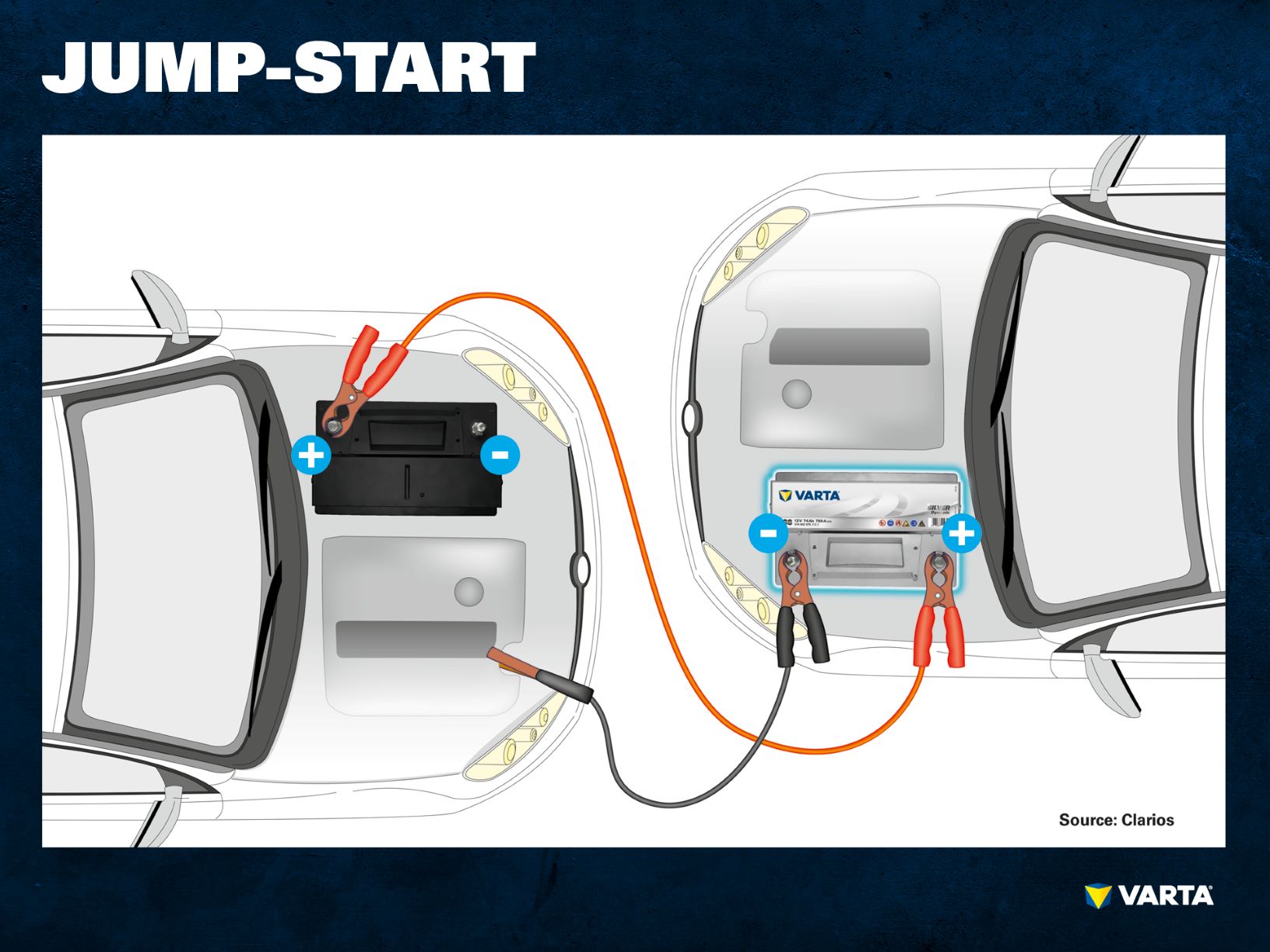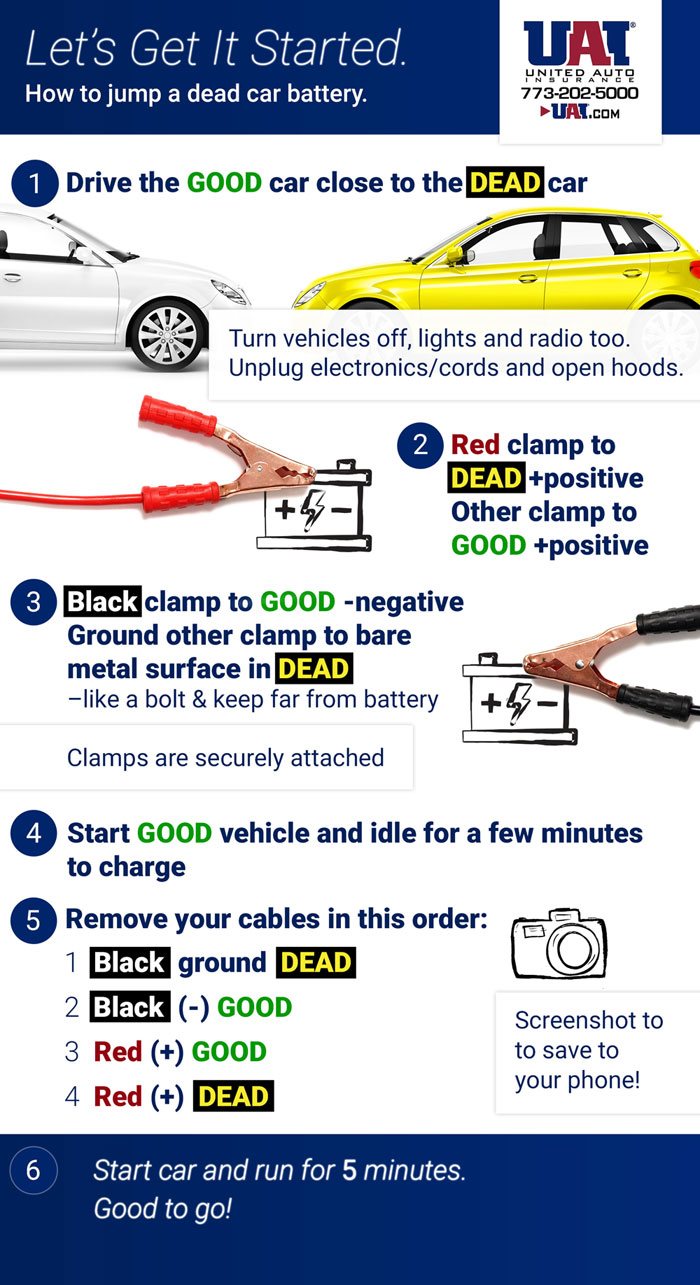Jump-starting a car is simple with the right steps. First, park both cars close, but not touching.
Next, connect jumper cables in the correct order. That’s the basic idea. Cars can sometimes leave us stranded. A dead battery is often the cause. Knowing how to jump-start a car is a valuable skill. It can save time and stress.
Imagine being stuck in a parking lot or on a road. Having this skill means you can get back on the road quickly. This guide will walk you through the process safely and efficiently. Whether you’re a seasoned driver or new to the road, understanding jump-starting is crucial. It’s not just about cables and cars; it’s about being prepared. Let’s dive into the essentials of jump-starting a car.

Credit: www.reddit.com
Introduction To Jump Starting
Jump starting a car is a useful skill. It can save time and money. Imagine your car battery dies in the middle of nowhere. Knowing how to jump start can get you back on the road quickly. This guide will help you understand the basics. You will learn the importance and common situations for jump starting a car.
Importance Of Knowing How
Every driver should know how to jump start a car. Car batteries can die without warning. This can happen at any time. A dead battery can ruin your plans. You might be late for work or miss an important event. Knowing how to jump start can save you from these troubles. It also helps you assist others who face the same problem. Helping someone with a dead battery can be a kind gesture.
Common Situations Requiring A Jump Start
Several situations might need a jump start. Cold weather can drain your car battery fast. Leaving headlights on overnight can also kill the battery. Sometimes, a car may not start after sitting idle for too long. In each case, jump starting your car can be the solution. It is a good idea to keep jump cables in your car. You will be ready for any battery trouble.

Credit: batteryworld.varta-automotive.com
Gather Necessary Tools
Before jump-starting a car, gather all required tools first. This step ensures safety and efficiency. You don’t want to be stranded without the essentials. Below are the must-have items and optional safety gear.
Essential Equipment
Firstly, get a set of jumper cables. These cables transfer power from one battery to another. Choose cables that are at least 10 feet long. Longer cables provide more flexibility. Also, ensure the cables are in good condition. Check for any frays or cuts.
Another option is a portable jump starter. This device is handy and doesn’t need another car. It’s a great backup if jumper cables aren’t available.
Optional Safety Gear
Safety should never be overlooked. Consider wearing gloves to protect your hands. Car batteries can leak acid, which is harmful. A pair of safety glasses shields your eyes from sparks.
Also, keep a flashlight nearby. It helps if you are working in the dark. Having a reflective vest makes you visible to other drivers. This is crucial if you are on the roadside.
Safety Precautions
Ensure the car is in park and the ignition is off before starting. Connect the red cable to the positive terminals and the black cable to the negative terminal on the good battery, then the car frame. Always stand back when starting the engine to avoid accidents.
Jump-starting a car can be a lifesaver when your battery dies unexpectedly. But before you grab those jumper cables, it’s crucial to prioritize safety. Understanding the right safety precautions not only protects you but also ensures your car’s electrical systems remain intact. This section highlights essential safety measures you should take before, during, and after jump-starting your vehicle.Personal Safety Tips
First, position the vehicles correctly. Park them close enough for the cables to reach but ensure they’re not touching. Wear gloves and safety glasses. It might seem excessive, but a spark can cause serious injury. Always turn off both vehicles before connecting the cables. This prevents any sudden electric discharge.Preventing Electrical Damage
Identify the positive and negative terminals. Connecting them incorrectly can fry your car’s electronics. Ensure the cables are in good condition. Frayed cables can lead to short circuits. Once the cables are connected, start the working car first. Let it run for a few minutes before attempting to start the dead car. Have you ever accidentally connected the wrong terminals and seen sparks fly? Such mistakes are common but can be easily avoided with a little attention. Remember, following these precautions could save you from costly repairs.Locate Battery Terminals
Understanding how to locate battery terminals is crucial. It is the first step to jump-starting a car. You need to ensure you connect the cables correctly. This prevents damage to your vehicle.
Most car batteries have two terminals. They are marked as positive and negative. Knowing which is which is essential for safety.
Identifying Positive And Negative
Look for the plus sign (+) on the battery. This indicates the positive terminal. It may also be marked with a red cover.
The negative terminal is marked with a minus sign (-). Often, it has a black cover. The negative terminal is usually connected to the car’s frame.
Checking Battery Condition
Before starting, check the battery’s condition. Look for corrosion or dirt on the terminals. This can block a good connection.
Clean the terminals with a wire brush if needed. Ensure they are dry and free of debris. A clean surface helps the cables work effectively.
Positioning Vehicles
Positioning vehicles correctly is crucial for a successful jump start. Proper placement ensures safety and efficiency. Knowing how to align the cars can prevent accidents. It also makes the process smoother. This section will guide you through optimal car placement and ensuring stability.
Optimal Car Placement
Place the cars close enough to connect jumper cables easily. They should face each other or stand side by side. Keep the distance short to avoid cable strain. Avoid blocking traffic or creating hazards on busy roads. Parking lots are ideal for this task.
Ensure both cars are turned off before positioning. Check that the parking brakes are engaged. This prevents any unwanted movement. Align the hoods for easy access to the batteries. This step simplifies the connection process.
Ensure Stability
Stability is key during a jump start. Ensure the cars are on flat ground. Avoid uneven surfaces that might cause rolling. Engage the parking brake in both vehicles. This ensures they stay put during the procedure.
Check for stability before connecting cables. Rock each car gently to confirm they are secure. This helps prevent accidents during the jump start. Stability reduces risks and increases safety.
Connecting Jumper Cables
Jump-starting a car can seem daunting. But it’s a simple process with clear steps. Connecting jumper cables is crucial. It can bring your car back to life. Ensure you follow the steps carefully. This prevents damage to the cars.
Correct Cable Sequence
First, park the working car close to the dead one. Make sure they don’t touch. Turn off both ignitions. Open the hoods and locate the batteries. Find the positive and negative terminals. The positive is marked with a plus sign (+). The negative with a minus sign (-).
Now, connect one red clamp to the dead battery’s positive terminal. Then, attach the other red clamp to the positive terminal of the working battery. Next, connect one black clamp to the working battery’s negative terminal. Finally, attach the last black clamp to an unpainted metal surface on the dead car.
Avoiding Cable Mishaps
Never let the clamps touch each other. This can cause sparks or damage. Check the cables for any damage before using them. Damaged cables can be dangerous. Ensure the clamps are securely attached. Loose clamps may not transfer power effectively.
Keep the cables away from moving parts. This avoids them getting tangled or damaged. Always follow safety guidelines. This protects you and the vehicles.
Starting The Engine
Jump starting a car involves using jumper cables to connect your battery to another vehicle’s battery. Ensure both cars are turned off before connecting the cables. Follow the proper order for attaching the cables to avoid damage.
Starting a car with a dead battery can feel daunting. But with a little guidance, it’s a straightforward task. Once the jumper cables are connected, the next crucial step is starting the engine. This part is essential to reviving the dead car. Follow these steps carefully to ensure a smooth process.Turn On The Donor Car
Begin by turning on the donor car. Allow it to run for a few minutes. This gives the dead battery time to receive a charge. Make sure the donor car’s engine is running smoothly. Check that all connections are secure. Listen for a steady engine hum. This indicates the donor car is ready to help.Attempting To Start The Dead Car
Now, try to start the dead car. Turn the key in the ignition. Listen for the engine’s response. If it doesn’t start immediately, don’t worry. Give it a few seconds, then try again. Sometimes, the battery needs more time to charge. If the car begins to start, keep it running. This will help the battery regain power. If unsuccessful after a few attempts, check the connections again. Make sure everything is in place before trying once more.
Credit: www.unitedautoinsurance.com
Disconnecting Cables Safely
Safely disconnecting cables is crucial after jump-starting a car. First, turn off the engine. Remove the negative cable from the car receiving the jump, then from the donor vehicle. Finally, detach the positive cable in the same order. This prevents sparks and electrical issues, ensuring a smooth disconnection process.
Jump-starting a car can be a lifesaver in many situations. However, knowing how to disconnect the cables safely is crucial to avoid any damage or injury. This step is just as important as connecting the cables properly. Let’s dive into the process of safely disconnecting the cables after your car is up and running.Proper Cable Removal
First, turn off both vehicles. Removing the cables while the engines are running can be dangerous. Start by removing the negative (black) cable from the car that was jump-started. Remember, the negative cable should always be the first to be disconnected. Next, remove the negative cable from the car that provided the jump. Following the same sequence ensures there’s no accidental short circuit. Finally, remove the positive (red) cable from the car that provided the jump, and then from the car that was jump-started. Always double-check that the cables are not touching any metal surfaces during this process.Final Checks Before Driving
Before you hit the road, ensure that everything is in place. Check that the cables are stored safely and not hanging out of the hood. Also, it’s a good idea to let the jump-started car run for a few minutes. This helps the battery recharge a bit more. Lastly, ask yourself: Is everything back to normal? Check your dashboard for any warning lights and listen for unusual sounds. If anything seems off, it might be wise to get a professional check-up. Jump-starting a car can be straightforward, but the key is to handle each step with care. What’s the most challenging part you’ve faced when jump-starting a car? Share your thoughts in the comments!Troubleshooting Issues
Jump-starting a car usually gets you back on the road quickly. Sometimes, though, it doesn’t work right away. This can be frustrating, especially if you’re in a hurry. Knowing how to troubleshoot can save you time and stress. Let’s explore common issues and their solutions.
What To Do If It Doesn’t Start
If your car doesn’t start after you jump it, check the connections. Ensure the jumper cables are attached firmly to the battery terminals. Loose connections can prevent the charge from flowing properly.
If the cables are secure, give it a few more minutes. Sometimes, the battery needs a bit more time to charge. Try starting the car again. If it still doesn’t start, the battery might be too far gone. You might need to replace it.
Identifying Persistent Problems
If your car starts but then dies again, you might have a different issue. The problem could lie in the alternator or another part of the electrical system. A failing alternator can’t keep the battery charged. This could be why your car won’t stay running.
Maintenance Tips For Prevention
Knowing how to jump start a car is essential for every driver. Start by connecting jumper cables properly to avoid damage. Regularly check your battery’s condition to prevent unexpected breakdowns.
Jump-starting a car is a handy skill, but wouldn’t it be better to avoid the situation altogether? Proper maintenance is the key to preventing those dreaded moments when your car won’t start. Regular attention to your battery and understanding the early signs of wear can keep your vehicle in top shape. Let’s dive into some practical tips to keep your battery healthy and reliable.Regular Battery Checks
Regularly checking your battery can save you from unexpected breakdowns. Make it a habit to inspect the battery terminals for corrosion. A simple cleaning with a mix of baking soda and water can keep them shining. Ensure the battery is secured tightly. A loose battery can cause vibrations that may damage the internal components. Look at the battery’s fluid levels if it’s not sealed. Low levels can lead to overheating and reduce efficiency. In my experience, keeping a maintenance log helps track checks and any notable changes. It’s a small effort that pays off big time.Signs Of Battery Wear
Recognizing battery wear early can prevent a total breakdown. Pay attention to slow engine cranks. If your car struggles to start, your battery might be losing its charge. Look for dimming headlights. This can be a sign that your battery isn’t providing enough power. Check for a bloated battery case. Excessive heat can cause the battery to swell, indicating it’s on its last legs. Have you ever noticed a rotten egg smell? That’s usually a warning sign of battery leakage. These symptoms are your car’s way of telling you it’s time for a battery check-up. Would you want to be caught off guard on a cold morning? Keep these insights in mind and make battery maintenance a regular part of your routine.Frequently Asked Questions
What Is The Correct Order To Jump Start A Car Battery?
Start by connecting the red jumper cable to the positive terminal of the dead battery. Attach the other red cable to the positive terminal of the good battery. Connect the black cable to the negative terminal of the good battery.
Finally, attach the other black cable to an unpainted metal surface on the car with the dead battery.
What Are The 5 Steps To Jumpstart A Car?
1. Park both cars close, ensuring they don’t touch. 2. Turn off engines and connect red clamp to dead battery’s positive terminal. 3. Attach other red clamp to donor battery’s positive terminal. 4. Connect black clamp to donor battery’s negative terminal.
5. Attach remaining black clamp to unpainted metal surface on dead car. Start donor car, then dead car.
Which Cable To Put On First When Jumping A Car?
Attach the red (positive) cable to the dead car’s positive terminal first. Then connect the other end to the donor car’s positive terminal.
What Order Do Jump Leads Go In?
Connect the red lead to the positive terminal of the dead battery, then to the positive terminal of the live battery. Attach the black lead to the negative terminal of the live battery, and finally to a metal part of the car with the dead battery, away from the battery.
Conclusion
Jump-starting a car is a simple skill. Essential for drivers everywhere. Keep jumper cables in your car always. They could save your day. Make sure both car batteries are compatible. Connect cables in the right order. Red to positive. Black to negative.
Safety first. Don’t touch metal parts. Start the working car. Then try your car. Let it run for a few minutes. Disconnect cables carefully. Drive for 15-30 minutes to recharge the battery. Practice makes it easier. You’ll gain confidence each time.
Stay prepared and safe on the road.
